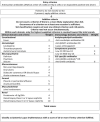A Comprehensive Literature Review on Managing Systemic Lupus Erythematosus: Addressing Cardiovascular Disease Risk in Females and Its Autoimmune Disease Associations
- PMID: 37727166
- PMCID: PMC10505685
- DOI: 10.7759/cureus.43725
A Comprehensive Literature Review on Managing Systemic Lupus Erythematosus: Addressing Cardiovascular Disease Risk in Females and Its Autoimmune Disease Associations
Abstract
This review aimed to evaluate the mechanism of premature cardiovascular disease (CVD) in systemic lupus erythematosus (SLE) patients, particularly in the female population, and emphasize the need for early management interventions; explore the association between SLE and two autoimmune diseases, myasthenia gravis (MG) and antiphospholipid antibody syndrome (APS), and their management strategies; and evaluate the effectiveness of pharmacological and non-pharmacological interventions in managing SLE, focusing on premenopausal females, females of childbearing age, and pregnant patients. We conducted a comprehensive literature review to achieve these objectives using various databases, including PubMed, Google Scholar, and Cochrane. The collected data were analyzed and synthesized to provide an evidence-based overview of SLE, its management strategies as an independent disease, and some disease associations. The treatment should be focused on remission, preventing organ damage, and improving the overall quality of life (QOL). Extensive emphasis should also be focused on diagnosing SLE and concurrent underlying secondary diseases timely and managing them appropriately.
Keywords: adverse pregnancy outcomes; antiphospholipid antibody syndrome; cardiac manifestations; myasthenia gravis; serum biomarkers; systemic lupus erythematosus; therapeutic interventions.
Copyright © 2023, Dar et al.
Conflict of interest statement
The authors have declared that no competing interests exist.
Figures










Similar articles
-
Systemic Lupus Erythematosus and Secondary Antiphospholipid Syndrome after Thymectomy for Myasthenia Gravis - A Case Report.Open Access Maced J Med Sci. 2015 Sep 15;3(3):439-42. doi: 10.3889/oamjms.2015.096. Epub 2015 Aug 26. Open Access Maced J Med Sci. 2015. PMID: 27275267 Free PMC article.
-
Thymectomy and systemic lupus erythematosus (SLE).Ann Ital Chir. 2014 Nov-Dec;85(6):617-8. Ann Ital Chir. 2014. PMID: 25919914
-
Antiphospholipid antibodies and non-thrombotic manifestations of systemic lupus erythematosus.Lupus. 2018 Apr;27(4):665-669. doi: 10.1177/0961203317734924. Epub 2017 Oct 19. Lupus. 2018. PMID: 29050535
-
Biochemical and clinical predictors in pregnant women with antiphospholipid syndrome and systemic lupus erythematosus: comprehensive update.Arch Gynecol Obstet. 2021 Nov;304(5):1153-1160. doi: 10.1007/s00404-021-06178-5. Epub 2021 Aug 14. Arch Gynecol Obstet. 2021. PMID: 34390384 Review.
-
Addressing the unspoken: sexual dysfunction in men with systemic lupus erythematosus, a call to action for rheumatologists.Sex Med Rev. 2024 Jun 26;12(3):434-441. doi: 10.1093/sxmrev/qeae033. Sex Med Rev. 2024. PMID: 38796305 Review.
Cited by
-
Coexistent pleural effusion is found to be associated with aggravated subclinical myocardial injury in systemic lupus erythematous using cardiovascular magnetic resonance imaging.Front Immunol. 2024 Nov 25;15:1504624. doi: 10.3389/fimmu.2024.1504624. eCollection 2024. Front Immunol. 2024. PMID: 39654879 Free PMC article.
-
Cardiovascular Events in Lupus Nephritis: A Systematic Review and Meta-Analysis.Glomerular Dis. 2025 Apr 30;5(1):261-277. doi: 10.1159/000546177. eCollection 2025 Jan-Dec. Glomerular Dis. 2025. PMID: 40539000 Free PMC article.
-
Upper gastrointestinal hemorrhage as a manifestation of systemic lupus erythematosus: a case report.J Med Case Rep. 2025 Aug 5;19(1):391. doi: 10.1186/s13256-025-05419-4. J Med Case Rep. 2025. PMID: 40764592 Free PMC article.
-
Organizational Climate and Decision Aid Sustainability in Lupus Care: Mixed Methods Study.JMIR Form Res. 2025 Aug 21;9:e69603. doi: 10.2196/69603. JMIR Form Res. 2025. PMID: 40838956 Free PMC article.
References
-
- Systematic review of the epidemiology of systemic lupus erythematosus in the Asia-Pacific region: prevalence, incidence, clinical features, and mortality. Jakes RW, Bae SC, Louthrenoo W, Mok CC, Navarra SV, Kwon N. Arthritis Care Res (Hoboken) 2012;64:159–168. - PubMed
-
- Manifestations of systemic lupus erythematosus. Cojocaru M, Cojocaru IM, Silosi I, Vrabie CD. https://www.ncbi.nlm.nih.gov/pmc/articles/PMC3391953/ Maedica (Bucur) 2011;6:330–336. - PMC - PubMed
-
- Review article: systemic lupus erythematosus: a review for anesthesiologists. Ben-Menachem E. Anesth Analg. 2010;111:665–676. - PubMed
-
- Systemic lupus erythematosus and accelerated atherosclerosis. Hahn BH. N Engl J Med. 2003;349:2379–2380. - PubMed
-
- Monitoring systemic lupus erythematosus in standard clinical care. Petri M. Best Pract Res Clin Rheumatol. 2007;21:687–697. - PubMed
Publication types
LinkOut - more resources
Full Text Sources
Miscellaneous
